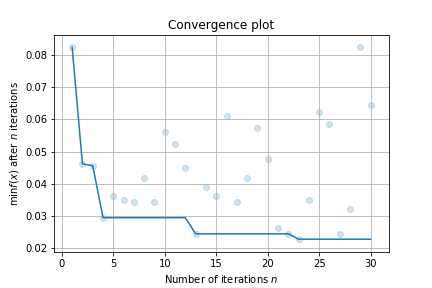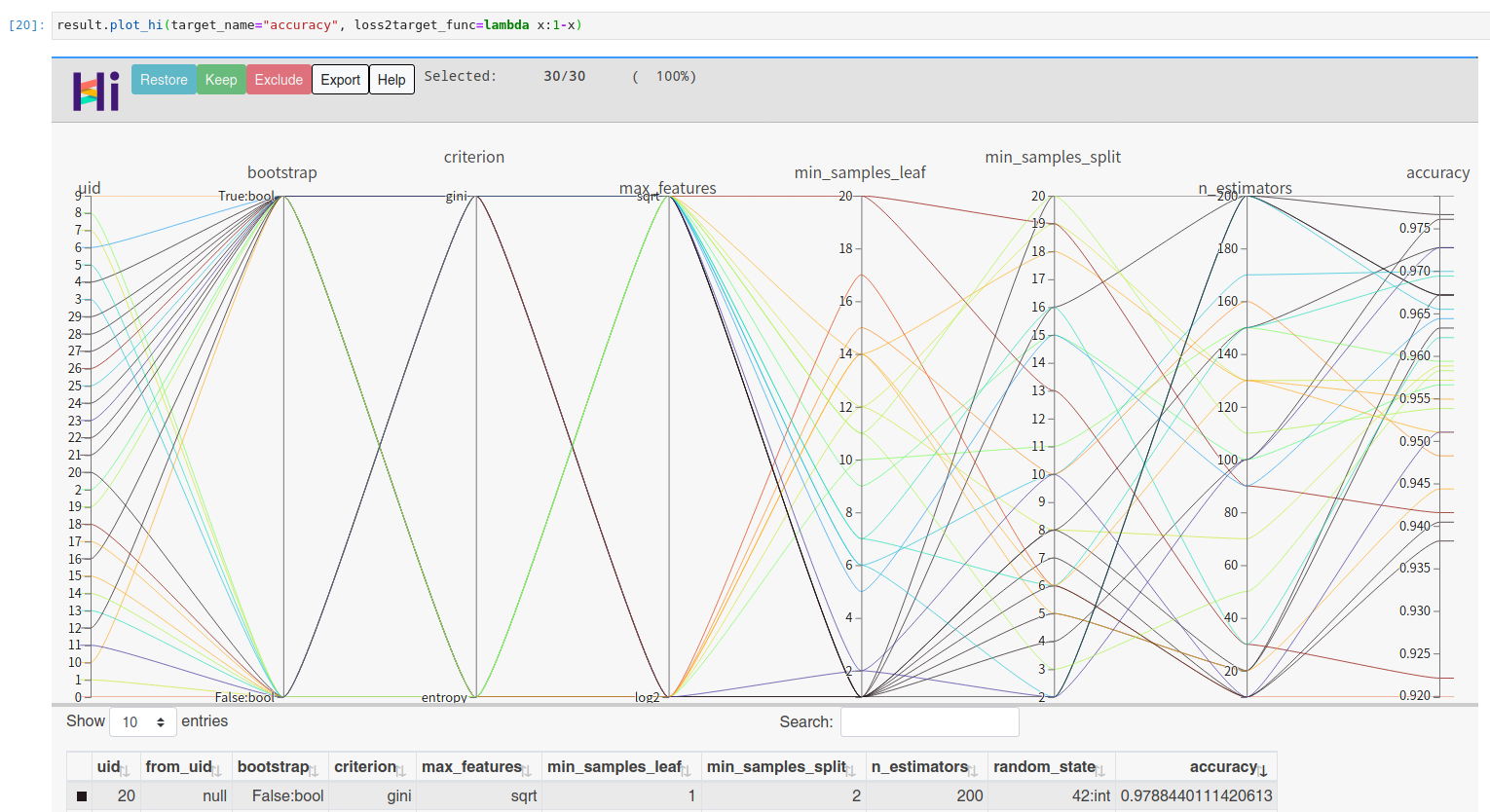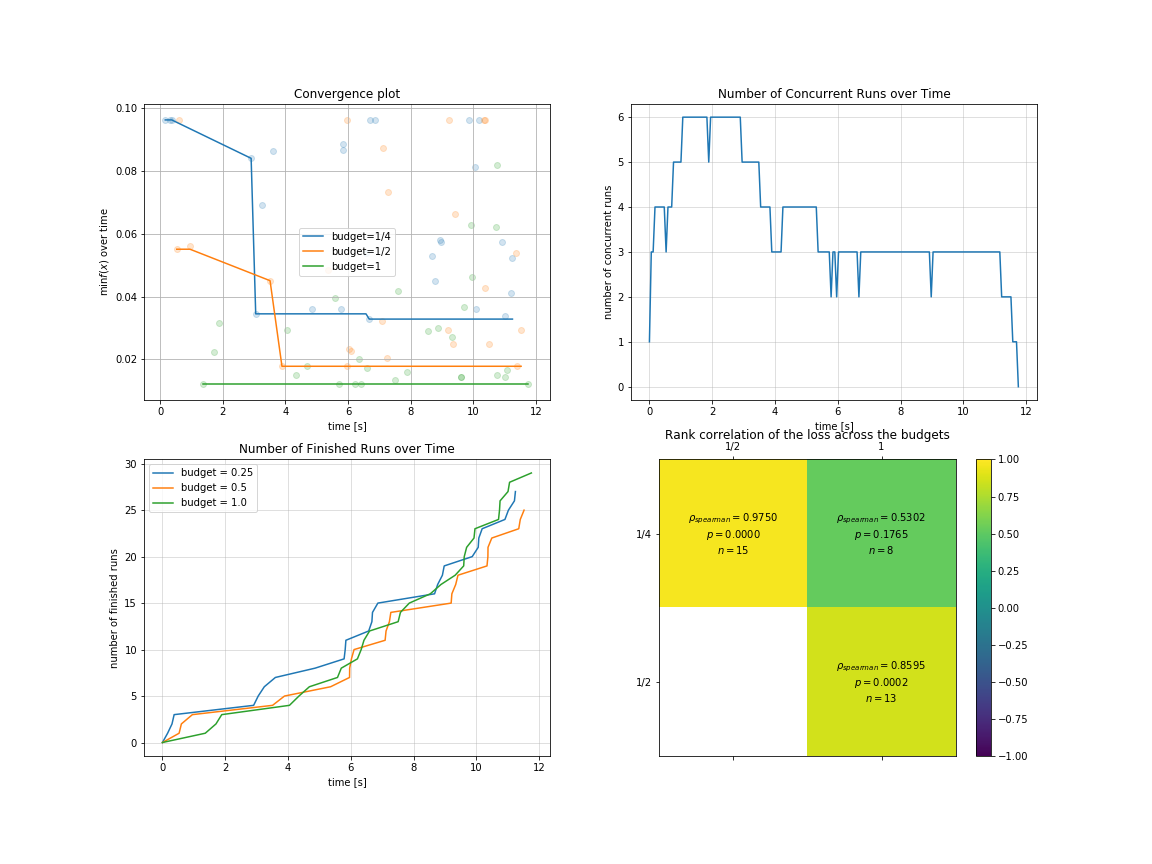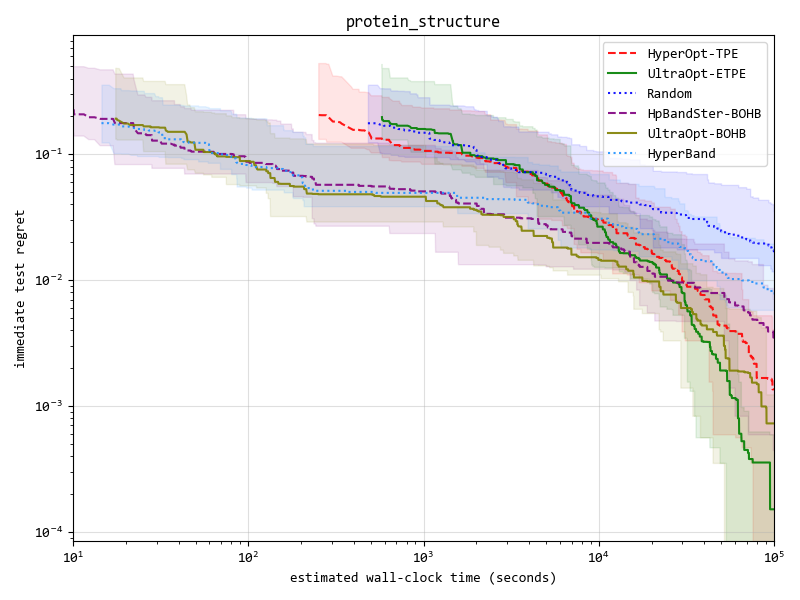
[](https://travis-ci.org/auto-flow/ultraopt)
[](https://badge.fury.io/py/ultraopt)
[](https://pypi.python.org/pypi/ultraopt)


[](https://github.com/auto-flow/ultraopt/stargazers) [](https://github.com/auto-flow/ultraopt/network)
[](https://zenodo.org/record/4430148)
`UltraOpt` : **比HyperOpt更强的分布式异步超参优化库**。
---
`UltraOpt` 是一个简单有效的优化库用于优化含噪音且评估代价大的黑盒函数,他能在大量的领域中应用,如超参优化(HyperParameter Optimization,HPO)和自动机器学习(Automatic Machine Learning,AutoML)。
在吸收了已有的优化库,如[HyperOpt](https://github.com/hyperopt/hyperopt)[[5]](#refer-5), [SMAC3](https://github.com/automl/SMAC3)[[3]](#refer-3), [scikit-optimize](https://github.com/scikit-optimize/scikit-optimize)[[4]](#refer-4) and [HpBandSter](https://github.com/automl/HpBandSter)[[2]](#refer-2)的优点后,我们开发了 `UltraOpt` ,它实现了一个新的贝叶斯优化算法:ETPE(Embedding-Tree-Parzen-Estimator,嵌入树形Parzen估计器),在我们的实验中,这个算法比HyperOpt的TPE算法表现更好。除此之外,`UltraOpt` 的优化器被重新设计为能够适应**HyperBand 和 SuccessiveHalving 评价策略**[[6]](#refer-6)[[7]](#refer-7)和**MapReduce 和 异步通信 计算场景**。最后,你可以通过`UltraOpt`的工具函数对`配置空间`和`优化过程与结果`进行可视化。
其他语言: [English README](README.md)
- **Documentation**
+ English Documentation is not available now.
+ [中文文档](https://auto-flow.github.io/ultraopt/zh/)
- **Tutorials**
+ English Tutorials is not available now.
+ [中文教程](https://github.com/auto-flow/ultraopt/tree/main/tutorials_zh)
**Table of Contents**
- [Installation](#Installation)
- [Quick Start](#Quick-Start)
+ [Using UltraOpt in HPO](#Using-UltraOpt-in-HPO)
+ [Using UltraOpt in AutoML](#Using-UltraOpt-in-AutoML)
- [Our Advantages](#Our-Advantages)
+ [Advantage One: ETPE optimizer is more competitive](#Advantage-One-ETPE-optimizer-is-more-competitive)
+ [Advantage Two: UltraOpt is more adaptable to distributed computing](#Advantage-Two-UltraOpt-is-more-adaptable-to-distributed-computing)
+ [Advantage Three: UltraOpt is more function comlete and user friendly](#advantage-three-ultraopt-is-more-function-comlete-and-user-friendly)
- [Citation](#Citation)
- [Referance](#referance)
# Installation
UltraOpt 需要 Python 3.6 或更高.
You can install the latest release by `pip`:
```bash
pip install ultraopt
```
你可以下载仓库后手动安装:
```bash
git clone https://github.com/auto-flow/ultraopt.git && cd ultraopt
python setup.py install
```
# Quick Start
## Using UltraOpt in HPO
让我们通过几个例子学习`UltraOpt`(你可以在`Jupyter Notebook`中尝试)。
你可以在 [这里](https://auto-flow.github.io/ultraopt/zh/_tutorials/01._Basic_Tutorial.html) 学习基础教程, 在 [这里](https://auto-flow.github.io/ultraopt/zh/_tutorials/02._Multiple_Parameters.html)学习`HDL`的定义。
在开始一个黑盒优化任务前,你需要提供两个东西:
- 参数的取值范围,或称 **配置空间(Config Space)**
- 目标函数, 接受 `config` (`config` 是 **Config Space**的一个采样), 返回 `loss`
让我们定义一个随机森林的 **Config Space** 通过 `UltraOpt`的 `HDL` (Hyperparameter Description Language,超参描述语言):
```python
HDL = {
"n_estimators": {"_type": "int_quniform","_value": [10, 200, 10], "_default": 100},
"criterion": {"_type": "choice","_value": ["gini", "entropy"],"_default": "gini"},
"max_features": {"_type": "choice","_value": ["sqrt","log2"],"_default": "sqrt"},
"min_samples_split": {"_type": "int_uniform", "_value": [2, 20],"_default": 2},
"min_samples_leaf": {"_type": "int_uniform", "_value": [1, 20],"_default": 1},
"bootstrap": {"_type": "choice","_value": [True, False],"_default": True},
"random_state": 42
}
```
然后再定义一个目标函数:
```python
from sklearn.ensemble import RandomForestClassifier
from sklearn.datasets import load_digits
from sklearn.model_selection import cross_val_score, StratifiedKFold
from ultraopt.hdl import layering_config
X, y = load_digits(return_X_y=True)
cv = StratifiedKFold(5, True, 0)
def evaluate(config: dict) -> float:
model = RandomForestClassifier(**layering_config(config))
return 1 - float(cross_val_score(model, X, y, cv=cv).mean())
```
现在,让我们开启一个优化过程:
```python
from ultraopt import fmin
result = fmin(eval_func=evaluate, config_space=HDL, optimizer="ETPE", n_iterations=30)
result
```
```
100%|██████████| 30/30 [00:36<00:00, 1.23s/trial, best loss: 0.023]
+-----------------------------------+
| HyperParameters | Optimal Value |
+-------------------+---------------+
| bootstrap | True:bool |
| criterion | gini |
| max_features | log2 |
| min_samples_leaf | 1 |
| min_samples_split | 2 |
| n_estimators | 200 |
+-------------------+---------------+
| Optimal Loss | 0.0228 |
+-------------------+---------------+
| Num Configs | 30 |
+-------------------+---------------+
```
最后,进行一个简单的可视化:
```python
result.plot_convergence()
```

你可以通过 facebook 的 hiplot 查看高维交互图:
```python
!pip install hiplot
result.plot_hi(target_name="accuracy", loss2target_func=lambda x:1-x)
```

## Using UltraOpt in AutoML
让我们尝试一个更复杂的例子:通过BOHB算法[[2]](#refer-2)(结合了**HyperBand**[[6]](#refer-6)评价策略和 `UltraOpt`的 **ETPE** 优化器)解决AutoML的 **CASH 问题** [[1]](#refer-1) (Combination problem of Algorithm Selection and Hyperparameter optimization).
你可以在[这里](https://auto-flow.github.io/ultraopt/zh/_tutorials/03._Conditional_Parameter.html)学习条件参数和复杂`HDL`的定义,在[这里](https://auto-flow.github.io/ultraopt/zh/_tutorials/05._Implement_a_Simple_AutoML_System.html)学习怎么实现一个简单的AutoML,在[这里](https://auto-flow.github.io/ultraopt/zh/_tutorials/06._Combine_Multi-Fidelity_Optimization.html)学习AutoML的实现。
首先,我们需要定义一个解决 **CASH 问题** 的 `HDL` :
```python
HDL = {
'classifier(choice)':{
"RandomForestClassifier": {
"n_estimators": {"_type": "int_quniform","_value": [10, 200, 10], "_default": 100},
"criterion": {"_type": "choice","_value": ["gini", "entropy"],"_default": "gini"},
"max_features": {"_type": "choice","_value": ["sqrt","log2"],"_default": "sqrt"},
"min_samples_split": {"_type": "int_uniform", "_value": [2, 20],"_default": 2},
"min_samples_leaf": {"_type": "int_uniform", "_value": [1, 20],"_default": 1},
"bootstrap": {"_type": "choice","_value": [True, False],"_default": True},
"random_state": 42
},
"KNeighborsClassifier": {
"n_neighbors": {"_type": "int_loguniform", "_value": [1,100],"_default": 3},
"weights" : {"_type": "choice", "_value": ["uniform", "distance"],"_default": "uniform"},
"p": {"_type": "choice", "_value": [1, 2],"_default": 2},
},
}
}
```
然后,定义一个附加`budget`参数的目标函数,以适应**HyperBand**[[6]](#refer-6)评估策略:
```python
from sklearn.neighbors import KNeighborsClassifier
import numpy as np
def evaluate(config: dict, budget: float) -> float:
layered_dict = layering_config(config)
AS_HP = layered_dict['classifier'].copy()
AS, HP = AS_HP.popitem()
ML_model = eval(AS)(**HP)
scores = []
for i, (train_ix, valid_ix) in enumerate(cv.split(X, y)):
rng = np.random.RandomState(i)
size = int(train_ix.size * budget)
train_ix = rng.choice(train_ix, size, replace=False)
X_train,y_train = X[train_ix, :],y[train_ix]
X_valid,y_valid = X[valid_ix, :],y[valid_ix]
ML_model.fit(X_train, y_train)
scores.append(ML_model.score(X_valid, y_valid))
score = np.mean(scores)
return 1 - score
```
你应该实例化一个`multi_fidelity_iter_generator`对象,用来使用**HyperBand**[[6]](#refer-6)评估策略:
```python
from ultraopt.multi_fidelity import HyperBandIterGenerator
hb = HyperBandIterGenerator(min_budget=1/4, max_budget=1, eta=2)
hb.get_table()
```
|
iter 0 |
iter 1 |
iter 2 |
|
stage 0 |
stage 1 |
stage 2 |
stage 0 |
stage 1 |
stage 0 |
| num_config |
4 |
2 |
1 |
2 |
1 |
3 |
| budget |
1/4 |
1/2 |
1 |
1/2 |
1 |
1 |
让我们将 **HyperBand** 评估策略和 `UltraOpt`的 **ETPE** 优化器结合在一起 , 然后开启一个优化过程:
```python
result = fmin(eval_func=evaluate, config_space=HDL,
optimizer="ETPE", # using bayesian optimizer: ETPE
multi_fidelity_iter_generator=hb, # using HyperBand
n_jobs=3, # 3 threads
n_iterations=20)
result
```
```
100%|██████████| 88/88 [00:11<00:00, 7.48trial/s, max budget: 1.0, best loss: 0.012]
+--------------------------------------------------------------------------------------------------------------------------+
| HyperParameters | Optimal Value |
+-----------------------------------------------------+----------------------+----------------------+----------------------+
| classifier:__choice__ | KNeighborsClassifier | KNeighborsClassifier | KNeighborsClassifier |
| classifier:KNeighborsClassifier:n_neighbors | 4 | 1 | 3 |
| classifier:KNeighborsClassifier:p | 2:int | 2:int | 2:int |
| classifier:KNeighborsClassifier:weights | distance | uniform | uniform |
| classifier:RandomForestClassifier:bootstrap | - | - | - |
| classifier:RandomForestClassifier:criterion | - | - | - |
| classifier:RandomForestClassifier:max_features | - | - | - |
| classifier:RandomForestClassifier:min_samples_leaf | - | - | - |
| classifier:RandomForestClassifier:min_samples_split | - | - | - |
| classifier:RandomForestClassifier:n_estimators | - | - | - |
| classifier:RandomForestClassifier:random_state | - | - | - |
+-----------------------------------------------------+----------------------+----------------------+----------------------+
| Budgets | 1/4 | 1/2 | 1 (max) |
+-----------------------------------------------------+----------------------+----------------------+----------------------+
| Optimal Loss | 0.0328 | 0.0178 | 0.0122 |
+-----------------------------------------------------+----------------------+----------------------+----------------------+
| Num Configs | 28 | 28 | 32 |
+-----------------------------------------------------+----------------------+----------------------+----------------------+
```
你可以对 `多保真度` 场景下的优化过程与结果进行可视化:
```python
import pylab as plt
plt.rcParams['figure.figsize'] = (16, 12)
plt.subplot(2, 2, 1)
result.plot_convergence_over_time();
plt.subplot(2, 2, 2)
result.plot_concurrent_over_time(num_points=200);
plt.subplot(2, 2, 3)
result.plot_finished_over_time();
plt.subplot(2, 2, 4)
result.plot_correlation_across_budgets();
```

# Our Advantages
## Advantage One: ETPE optimizer is more competitive
我们实现了4种优化器(在下表中列出), 并且 `ETPE` 优化器是我们原创的优化器, 在我们的试验中,它比其他`基于TPE的优化器`如 `HyperOpt的TPE` 和 `HpBandSter的BOHB` 要表现更好。
Our experimental code is public available in [here](https://github.com/auto-flow/ultraopt/tree/main/experiments), experimental documentation can be found in [here](https://auto-flow.github.io/ultraopt/zh/experiments.html) .
|Optimizer|Description|
|-----|---|
|ETPE| Embedding-Tree-Parzen-Estimator, is our original creation, converting high-cardinality categorical variables to low-dimension continuous variables based on TPE algorithm, and some other aspects have also been improved, is proved to be better than `HyperOpt's TPE` in our experiments. |
|Forest |Bayesian Optimization based on Random Forest. Surrogate model import `scikit-optimize` 's `skopt.learning.forest` model, and integrate Local Search methods in `SMAC3`| .
|GBRT| Bayesian Optimization based on Gradient Boosting Resgression Tree. Surrogate model import `scikit-optimize` 's `skopt.learning.gbrt` model. |
|Random| Random Search for baseline or dummy model. |
Key result figure in experiment (you can see details in [experimental documentation](https://auto-flow.github.io/ultraopt/zh/experiments.html) ) :

## Advantage Two: UltraOpt is more adaptable to distributed computing
You can see this section in the documentation:
- [Asynchronous Communication Parallel Strategy](https://auto-flow.github.io/ultraopt/zh/_tutorials/08._Asynchronous_Communication_Parallel_Strategy.html)
- [MapReduce Parallel Strategy](https://auto-flow.github.io/ultraopt/zh/_tutorials/09._MapReduce_Parallel_Strategy.html)
## Advantage Three: UltraOpt is more function comlete and user friendly
UltraOpt is more function comlete and user friendly than other optimize library:
| | UltraOpt | HyperOpt |Scikit-Optimize|SMAC3 |HpBandSter |
|------------------------------------------|-------------|-------------|---------------|-------------|-------------|
|Simple Usage like `fmin` function |✓ |✓ |✓ |✓ |×|
|Simple `Config Space` Definition |✓ |✓ |✓ |×|×|
|Support Conditional `Config Space` |✓ |✓ |× |✓ |✓ |
|Support Serializable `Config Space` |✓ |×|× |×|×|
|Support Visualizing `Config Space` |✓ |✓ |× |×|×|
|Can Analyse Optimization Process & Result |✓ |×|✓ |×|✓ |
|Distributed in Cluster |✓ |✓ |× |×|✓ |
|Support HyperBand[[6]](#refer-6) & SuccessiveHalving[[7]](#refer-7) |✓ |×|× |✓ |✓ |
# Citation
```
@misc{Tang_UltraOpt,
author = {Qichun Tang},
title = {{UltraOpt : Distributed Asynchronous Hyperparameter Optimization better than HyperOpt}},
month = January,
year = 2021,
doi = {10.5281/zenodo.4430148},
version = {v0.1.0},
publisher = {Zenodo},
url = {https://doi.org/10.5281/zenodo.4430148}
}
```
-----
Reference
[1] [Thornton, Chris et al. “Auto-WEKA: combined selection and hyperparameter optimization of classification algorithms.” Proceedings of the 19th ACM SIGKDD international conference on Knowledge discovery and data mining (2013): n. pag.](https://arxiv.org/abs/1208.3719)
[2] [Falkner, Stefan et al. “BOHB: Robust and Efficient Hyperparameter Optimization at Scale.” ICML (2018).](https://arxiv.org/abs/1807.01774)
[3] [Hutter F., Hoos H.H., Leyton-Brown K. (2011) Sequential Model-Based Optimization for General Algorithm Configuration. In: Coello C.A.C. (eds) Learning and Intelligent Optimization. LION 2011. Lecture Notes in Computer Science, vol 6683. Springer, Berlin, Heidelberg.](https://link.springer.com/chapter/10.1007/978-3-642-25566-3_40)
[4] https://github.com/scikit-optimize/scikit-optimize
[5] [James Bergstra, Rémi Bardenet, Yoshua Bengio, and Balázs Kégl. 2011. Algorithms for hyper-parameter optimization. In Proceedings of the 24th International Conference on Neural Information Processing Systems (NIPS'11). Curran Associates Inc., Red Hook, NY, USA, 2546–2554.](https://dl.acm.org/doi/10.5555/2986459.2986743)
[6] [Li, L. et al. “Hyperband: A Novel Bandit-Based Approach to Hyperparameter Optimization.” J. Mach. Learn. Res. 18 (2017): 185:1-185:52.](https://arxiv.org/abs/1603.06560)
[7] [Jamieson, K. and Ameet Talwalkar. “Non-stochastic Best Arm Identification and Hyperparameter Optimization.” AISTATS (2016).](https://arxiv.org/abs/1502.07943)

